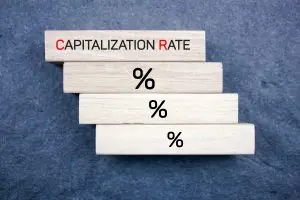Real estate investing offers a variety of methods to evaluate potential properties, and among the most widely used metrics is the capitalization rate, also known as the “cap rate.” While it provides valuable insights, investors need to understand both its advantages and limitations to make informed decisions. Let’s explore the pros and cons of using the cap rate in real estate analysis.
What is the Capitalization Rate?
The cap rate is a percentage that measures the return on a real estate investment based on its income-producing potential. It is calculated by dividing the property’s net operating income (NOI) by its current market value or purchase price:
For example, if a property generates an NOI of $50,000 and is valued at $500,000, its cap rate is 10%.

Let’s look at the Pros and Cons of the capitalization rate.
Pros of Using the Cap Rate
- Simplicity and Speed
The cap rate offers a quick snapshot of a property’s profitability, allowing investors to make swift comparisons between different investment opportunities. Just calculate the total rent and deduct the regular, recurring operating expenses. Simple. Right? - Standardized Benchmark
As a widely recognized metric, the cap rate provides a common basis to evaluate properties within a particular market or asset class. It is challenging to devise a metric that is as widely accepted. - Market Indicator
Changes in average cap rates within a region can reflect market sentiment, risk levels, or economic conditions, helping investors gauge the overall investment climate. - Useful for Initial Screening
It helps filter out properties that do not meet the desired return thresholds during the early stages of property analysis.
Cons of Using the Cap Rate
- Ignores Financing and Cash Flow Details
The cap rate is based on NOI, which doesn’t account for mortgage financing, taxes, or other personal costs. This limits its usefulness for calculating actual investor returns or cash flow. Other cash flow items that limit the usefulness of the cap rate include major repair items that would not otherwise fall under the definition of “regular, recurring expenses,” such as HVAC replacement, roof repairs, and legal expenses. Tenant improvements and commissions must be factored into any analysis. - Oversimplification of Market Conditions
Market values and income figures may not accurately reflect future potential or risks, potentially leading to misleading conclusions if used in isolation. The cap rate and other “rules of thumb” need to be applied with care. What are the expected deviations between geographical locations under consideration? - Variability Across Markets
Cap rates can vary significantly between regions, property types, and even periods, making direct comparisons complicated. A complete analysis of the local market is key to a successful real estate investment. - Doesn’t Consider Property-Specific Risks or Opportunities
The cap rate does not capture factors like deferred maintenance, lease expirations, or development potential. - Potential for Misuse
Relying solely on cap rates without a comprehensive, multi-year analysis can lead to poor investment decisions, especially if the underlying assumptions are flawed. How sensitive is the return on the potential investment to changes in the assumptions in your analysis? If the market cap rate goes up after a few years, what will be the projected impact on the investor’s ROI or IRR?
Final Thoughts
The capitalization rate is a valuable tool for preliminary property evaluation, offering a quick measure of income relative to value. However, it should not be used in isolation. A thorough investment analysis should incorporate additional metrics, such as cash-on-cash returns and internal rate of return (IRR), as well as qualitative factors like market trends and property condition.
By understanding its strengths and limitations, investors can better leverage the cap rate as part of a comprehensive strategy for successful real estate investing.
For additional information on the use and calculation of cap rates, please check out our course, 11 Steps to Investing in Real Estate for Your Future.






